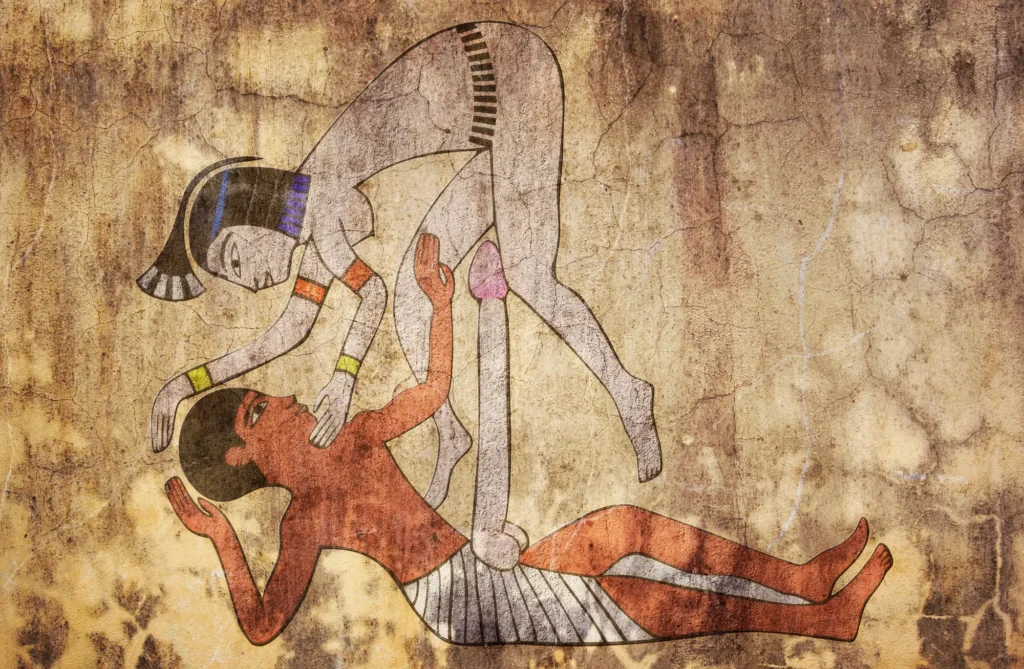Sexual culture has been an integral part of human societies for centuries, shaping itself in different ways in different regions and historical periods. This is a fascinating field of research that allows us to understand how people perceive and interpret sexuality in the context of their culture, religion and traditions. Let’s take a closer look at sexual diversity in various ancient cultures. By exploring these topics, we discover the richness and complexity of the human approach to sexuality, which is both a source of controversy and fascination.
Table of Contents:
- The influence of culture on human sexual life
- The sexual culture of ancient Egypt
- Sexuality in ancient Mesopotamia
- Sexual mores in ancient Rome
- Sexual culture of ancient Greece
- Sexual norms and practices in ancient Japan
The influence of culture on human sexual life
Culture, as an extremely important aspect of human life, actively shapes and defines an individual’s sexual experience. Over the centuries, traditions, social norms and religious beliefs, have had a profound impact on the formation of various sexual ideas and practices. From ancient civilizations to modern societies, culture has played a key role in shaping the sexuality of individuals and communities as a whole. Let’s take a closer look at the various cultural factors that influence sex life.
Editorial recommends: Sexting: the art of digital intimacy – how to ignite a relationship?
Traditionalist values may promote monogamous relationships, while a polygamous culture may tolerate or even promote polygamy. Religious beliefs often set moral and ethical boundaries regarding sexuality, determining what is acceptable and what is condemned. Analyzing these complex factors provides a better understanding of how culture shapes ideas about motherhood, sexuality and sexual function.
The sexual culture of ancient Egypt
The ancient Egyptians had an exceptionally developed sexual culture, which played an important role in their daily life as well as their religious life. In ancient Egyptian society, sexuality was closely linked to religion and mythology. The Egyptians believed that the afterlife was a continuation of earthly life, so matters related to sex and fertility were of great importance. Sexuality was seen as a gift from the gods and was important for both the fertility of the earth and human reproduction.
Monogamy was preferred
Monogamy was the preferred form of union, but polygyny, or polygynous unions, were also practiced, especially among the upper classes. Many of these relationships were pragmatic, serving to strengthen the social and political position of the families. Gender equality was much more developed than in many other cultures of the time. Women had certain rights, could inherit property and run their own businesses, which contributed to greater sexual freedom.
Ancient Egyptian culture also had taboos related to sexuality, especially regarding sexual behavior outside of marriage. However, unlike some other ancient cultures, the Egyptians did not have elaborate ceremonies or punitive laws regarding infidelity.
The overall sexual culture of ancient Egypt was thus rich and complex, encompassing religious, social and practical aspects. It was a culture that reflected the deep rootedness of sexuality in the social and religious life of the time.

Incestuous relationships led to serious genetic defects
In ancient times in Egypt, the practice of incest was common not only among the upper classes, but also among ordinary citizens. Today, many Western countries are more tolerant, towards such unions (including Spain, Portugal, the Netherlands, Belgium and Sweden, where half-siblings can even marry each other), even though they carry serious genetic risks. For example, marriages between cousins or siblings may be accepted, despite knowledge of potential health risks.
In contrast, attitudes toward incest were radically different in ancient Greece. Oedipus, a figure from Greek mythology, symbolized firm opposition to such practices. Accusations of incest not only entailed damage to reputations, but also faced social disapproval. Even if the Greeks were not aware of the specific genetic effects of incest, they believed that the offspring of related individuals would be weak, diseased and incapable of normal social life. In other words, they believed that if two people conducted an incestuous relationship, their children could experience serious health problems.
The consequences of such relationships include a higher risk of pregnancy complications, infertility and low birth weight. In addition, the practice of incest can lead to a higher incidence of recessive traits, which in turn increases the risk of serious genetic defects in offspring. Although it is unclear why such compounds were common in ancient Egypt, scientists confirm their negative impact on the health of future generations.
The sacred nature of sex
In ancient Egypt, sex was revered as an act of creation, considered a sacred ritual. The Egyptians believed that it was through sex that the process of creation took place, and so they treated it with the utmost respect. The first god was Atum, who, living in solitude, created the world through the act of masturbation. Later, the first gods were twins, which were formed from his ejaculations, thus symbolizing the beginning of life. For the pharaohs of ancient Egypt, sex was not only a physical activity, but also an important part of their spiritual life.
The Egyptians attributed a “sacred nature” to sex, seeing it as the foundation of society. This is evidenced even in their literature, such as the Book of the Dead, which contains references to homosexual desire. This proves that the ancient Egyptians were not only aware of the existence of homosexuality, but also practiced it.
Sexuality in ancient Mesopotamia
A look at past sexual cultures can be surprisingly diverse and fascinating. Take ancient Mesopotamia, for example, a region inhabited by civilizations such as the Sumerians, Assyrians and Babylonians. Their approach to sexuality was complex and sometimes interpreted differently by different communities and periods.
Rituals and sacrality
In ancient Mesopotamia, sexuality was often viewed through a religious prism. There were sexual rituals and practices that played a role in fertility cults, as well as in beliefs associated with gods and goddesses who cared for fertility, such as. Ishtar or Innana. These rituals often took place in temples, where priestesses, or priests, acted as intermediaries between the people and the gods.
The concept of fertility
Many ancient Mesopotamians placed a high value on fertility and reproduction. Marriages were often intended to ensure the continuation of the family and collective prosperity. Sometimes there were even practices to increase fertility, such as using amulets or applying special techniques during intercourse.

Status of women
The status and role of women in Mesopotamian culture varied depending on the historical period and the specific community. There were texts and legal documents that mandated the protection of women’s rights in marriage and the home, although men usually had more control over society.
Sacred prostitution
In some parts of Mesopotamia, there was a practice of sacred prostitution, where women acted as priestesses in temples and offered their sexual services as part of fertility cult rituals. Some of these practices may have been considered a form of worship to the gods, while others may have served as a source of income for the temple.
The concept of sexual morality
As in other ancient societies, Mesopotamian culture had its own norms regarding sexual morality. Some of the texts from that period may suggest that it was a relatively open community about sexual issues, but at the same time there were certain expectations and taboos about marriage, fidelity and reproduction.
Read also: Mexico City – explore the fascinating city of culture and art
Sexual mores in ancient Rome
Ancient Rome had a rich and complex sexual culture that evolved over the centuries and was partly shaped by various factors such as mythology, politics and social norms.
Mythology and religion
In ancient Rome, sexuality was often present in mythology and religion. The goddess of love Venus (equivalent to the Greek Aphrodite) was worshipped, and her worship influenced perceptions of love and its associated values. At the same time, there were also cults that practiced sexual rituals as a form of fertility worship.
Marriage and family
In ancient Rome, marriage was a vital institution for society. The purpose of marriage was to ensure the continuation of the family and social stability. However, despite the existence of arranged marriages, romantic love and attachment between spouses also took place.
The concept of sexual morality
As in other ancient societies, Rome had certain moral norms regarding sexuality. Marital fidelity was valued, although the practice was not always observed, especially for men who may have mistresses and even sex slaves.

Homosexuality
Homosexuality was present in ancient Rome, although the complexity and acceptance of the phenomenon varied depending on the historical period and social conditions. In some cultural circles, homosexual relations were accepted, while in others they may have been condemned.
Prostitution
Prostitution was common in ancient Rome and there were many different classes and forms of prostitution. Women working as prostitutes had different social statuses, and their activities were regulated by law depending on the circumstances.
Eroz and literature
Ancient Roman literature, including poems, dramas and satires, often dealt with themes of love and sexuality. Examples include works such as Ovid’s “Metamorphoses” and Juvenal’s satirical works, which often contained allusions to sexual matters.
Sexual culture of ancient Greece
The sexual culture of ancient Greece played an important role in shaping Western civilization and had a significant impact on perceptions of sexuality and human relationships.
Greek mythology
Sexuality was often present in Greek mythology, where gods and heroes were often depicted in love relationships and sexual adventures. For example, the myth of Zeu and Leda, which was a manifestation of fertility worship, or the myth of the romance between Hermes and Aphrodite, which explored the theme of marital infidelity.
Pederasty
In ancient Greece, pederasty, or an erotic relationship between a man and a boy, was a form of accepted social practice, especially in certain city-states such as Sparta and Athens. Pederastic relations had an educational and cultural aspect, and were sometimes formalized through rituals and social customs.
The essence of love and friendship
Romantic love and friendship were valued in ancient Greece and were important in the lives of individuals. Various forms of relationships developed, from partner love to deep friendship, which were explored in the literature and philosophy of the period.

Prostitution and heterism
There was prostitution in ancient Greece, but also heteria, a social formation in which women were kept by men in exchange for companionship, conversation and sex. Heterism was often culturally accepted and played an important role in social and cultural life.
Ethical values
In ancient Greece, there were various philosophical schools, such as Platonic and Stoic, which had their own views on morality and sexual ethics. Philosophers have often debated appropriate sexual behavior, the role of love and friendship in human life, and the importance of moderation and self-control.
Literature and art
Greek literature, like tragedies, comedies and poetry, often dealt with sexual and romantic themes, exploring various aspects of human nature and human relationships. Art, including sculpture and painting, also reflected the diversity of sexual experiences and social norms of the period.
Sexual norms and practices in ancient Japan
Ancient Japan had a rich cultural tradition that included a variety of approaches to sexuality and human relationships.
Shintoism and mythology
In ancient Japan, Shintoism, or indigenous religion, played an important role in shaping culture and society. Sexuality was present in Japanese mythology, where gods were often depicted in the context of amorous and erotic relationships.
Geisha and oiran
Japanese culture had an institution of geisha, who were skilled artists and companions, specializing in music, dance, poetry and conversation. Oiranas were a similar institution, but usually of higher social status, offering sexual services. Oiran is a collective term for the highest-ranking courtesans in Japanese history, who were considered superior to ordinary prostitutes (known as yūjo – “woman of pleasure”) because of their more refined entertainment skills and training in traditional arts.

Sexuality and art
Japanese art, including painting, sculpture and literature, often explored sexual themes. Examples include ukiyo-e prints, which often depicted scenes from everyday life, including erotic scenes and lovers.
Male lovers (wakashu)
In ancient Japan, there was a custom called wakashudo, which was a form of homosexuality where young boys (wakashu) were kept as lovers and disciples by older men. This practice influenced the literature, art and culture of the period. In Edo period Japan, adolescent boys were considered suitable objects of erotic desire for young women, older women and older men (as long as the latter played an active sexual role). Age was an important but non-key aspect of wakashū. In this way, older men could sometimes adopt the appearance and manners of wakashū. This was especially true for male prostitutes, who, once they reached adulthood, would not be considered a suitable object of homoerotic desire for older men (wakashūdo or shūdo).
The concept of sexual morality
Ancient Japan had its moral norms regarding sexuality, which were partly shaped by religion, tradition and social norms. Although there were certain expectations regarding sexual behavior, Japanese culture was more flexible and tolerant in some aspects compared to other cultures of the time.
Sexuality and ceremonies and rituals
In Japanese culture, there were rituals and ceremonies that had a sexual aspect, especially in the context of fertility worship and honoring gods associated with fertility and agriculture.
An exploration of various ancient sexual cultures sheds light on the diverse approaches to sexuality that existed in the past. From ancient Egypt to ancient Greece, ancient Mesopotamia, ancient Japan and ancient Rome, each of these cultures had its own taboos, myths and customs related to sexuality. Uncovering these cultural practices and beliefs allows us to better understand the human sexual experience in a historical and cultural context, and to analyze the impact that these cultural representations had on the daily and social life of the communities of the time.
Editorial recommends: Women’s rights in Rome, what is Roman marriage?





